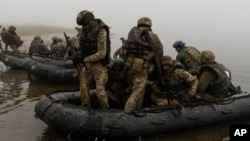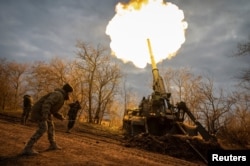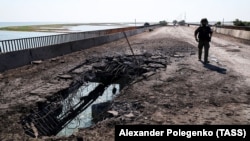The announcement published by Russian state news agencies raised eyebrows: A "regrouping" -- a tactical withdrawal to more favorable positions -- had been ordered by Russian commanders amid intense fighting on the eastern banks of the Dnieper River and reports of one or more growing Ukrainian bridgeheads.
Minutes later, the news story, which had cited the Defense Ministry, was withdrawn by TASS and RIA Novosti without explanation. The ministry then pointedly criticized the news agencies, calling their reporting a "provocation."
Tactical withdrawal or not, here's what the November 13 incident points to: There's a lot going on along a 45-kilometer stretch of marshy meadows and sandy riverbanks on the Russian-controlled side of the Dnieper, opposite and upriver from the Ukrainian-controlled city of Kherson.
Initial indications point to a growing Ukrainian operation that has not only sent dozens of troops and some heavy equipment across the river but has also tied up a substantial number of Russian forces, some redeployed from other hot spots along the 1,200-kilometer front line.
The effort itself -- sending troops and equipment across a waterway, exposed to artillery, air strikes, and drone surveillance -- is a complex, tricky endeavor. It comes with frustration growing about the trajectory of a slogging five-month counteroffensive that has garnered little territorial gain for Ukraine and done almost nothing to change the overall battlefield.
Roman Svitan, a Ukrainian defense analyst and reserve military officer, said there were three or four locations on the eastern bank where there were now established Ukrainian positions.
"For the moment these are not large-scale forces; these are reconnaissance, mostly small reconnaissance companies, up to 100 people," Svitan told Current Time. "It may already be up to a battalion, it may be larger, but these are only so-called raid attacks that are conducted on a rotational basis."
"In general river crossings are historically some of the hardest operations to successfully pull off," Kevin Ryan, a retired U.S. Army brigadier general and former U.S. defense attaché in Moscow, told RFE/RL. "And given the proliferation of drones and night vision devices, they are even harder in the current conflict."
You should be paying attention to what's happening on the Dnieper's left bank in the Kherson region. Here's why.
A Failed Counteroffensive?
In early June, Ukrainian troops kicked off a major counteroffensive, the largest since a pair of successful battlefield operations late last year. They were hoping to punch through Russian lines in several places: south of Orikhiv in the southern Zaporizhzhya region, south of Velyka Novosilka in the Donetsk region to the east, and further north around the obliterated Donetsk region city of Bakhmut.
There were glimmers of optimism when Ukrainian forces overcame some of the defenses known as the Surovikin Line, near Orikhiv. But they faced heavy equipment losses, so they retooled their approach, discarding some of the Western-led training that NATO had hoped would also provide an advantage.
Ukrainian commanders, and their Western military advisers, had also hoped that Russian troop strength was depleted either in terms of numbers or simple exhaustion. The Kremlin had resisted ordering a new mobilization similar to the massive call-up ordered by President Vladimir Putin in September 2022, and analysts speculated that some Russian units were either under strength or exhausted.
Russia partially proved doubters wrong in early October when it launched its own offensive focused mainly on Avdiyivka, an industrial city northwest of the regional capital, Donetsk. Though Ukrainian troops have held out, fears that they could be encircled remain.
In an interview published on November 1 in The Economist magazine, Ukraine's top military commander, General Valeriy Zaluzhniy, called the conflict a "stalemate."
What About Kherson?
In November 2022, after weeks of pressure from Ukrainian units, Russian commanders ordered a pullout of some 30,000 elite paratroopers and other forces from the western side of Dnieper River. The move restored Ukrainian control of the city of Kherson, which Russia had captured soon after its February 2022 invasion.
In June, a Dnieper River dam under Russian control at Nova Kakhovka was destroyed under not-fully-clear circumstances, flooding thousands of hectares downstream and causing widespread damage.
In the time since Russia's withdrawal from the western bank, Ukrainian special forces and reconnaissance units have made repeated forays across the river and further downstream at the river's mouth, the Dniprovska Gulf. Ukrainians started taking control of some of the upriver islands, along the Konka tributary.
Sometime around October 18, Russian war bloggers began reporting on Ukrainian marine infantry crossing the river and establishing firing positions about 8 kilometers upriver from the Antonivskiy Bridge. One early report said units reached the village of Pishchanivka, about 2 kilometers southeast of the riverbank.
Since then, clashes -- now reported outside of string of villages along the Konka -- have spread from Oleshky, nearly directly opposite the city of Kherson, upriver about 50 kilometers to Korsunka.
As of November 13, reports said the village of Krynky was the focus of most intense fighting, as well as outside Kozachi Laheri immediately to the west, with Russian forces struggling to hold back Ukrainian troops advancing south from the river.
Multiple Russian war bloggers, along with a handful of Ukrainian bloggers, say Ukrainian forces have managed to bring an unknown number of armored vehicles across the river and have used at least one attack helicopter to target Russian positions in an echo of a tactic used with substantial success by Russian forces against Ukrainian forces near Orikhiv.
Oleksandr Musiyenko, head of the Kyiv-based Center for Military and Legal Studies, asserted that the Ukrainian bridgehead now encompassed the entire stretch of the eastern riverbank from the Antonivskiy Bridge up to Krynky.
"This means that the enemy cannot displace our forces. If they can't push us out -- and they'd like to do it, obviously, and they have tried -- then it means they have problems in defense on this front," he told RFE/RL's Ukrainian Service. "I would not rule out this scenario in the future: that Russian troops will be forced to withdraw to other fronts. This has happened to them many times already; it should not be surprising here."
Ukraine's military has said virtually nothing about the operation except to confirm only that marine infantry troops were operating on the Dnieper's east bank. Natalya Humenyuk, a spokeswoman for Ukraine's southern command, said on November 14 that it appeared Russian forces might be prepared to withdraw away from the littoral positions, moving back to second or third defensive lines to the east and south.
"For now, [Russian units] are forced under the pressure of their own military and political leadership to hold on to those hastily arranged positions. They tried to move away from the big water, they dug in somewhere, tried to get a foothold," she said. "But we know all these positions and we're working them hard."
Russian officials have also said little, though the Defense Ministry claimed last month that it had thwarted an attempted river crossing.
This week, the Russian ministry was forced to respond to the confusion surrounding the retracted news reports by TASS and RIA Novosti, which said Dnieper group commanders had ordered a "regrouping" of forces to "more advantageous positions east of the Dnieper." The ministry called the retracted reports "a provocation."
An information agency created by Ukraine's Special Operations Forces denied there had been any withdrawal or "regrouping" by Russian forces, saying the Russian news reports were intended to deceive Ukraine.
Command Confusion?
Under the Russian command structure for the war, the "Dnieper" command grouping is responsible for the area of operations along the Dnieper, south toward Crimea, the occupied Black Sea peninsula.
Late last month, the group's commander, Colonel General Oleg Makarevich, was abruptly removed from his position by Putin and replaced with Colonel General Mikhail Teplinsky, who had previously served as head of Russia's elite Airborne Forces, and who had directly overseen last year's withdrawal from the Dnieper's west bank.
Vladimir Rogov, a Moscow-backed official in the Russian-occupied part of the Kherson region, claimed Makarevich was fired, pushed out due to misleading superior officers and Defense Ministry officials about the difficult situation in Kherson.
Days after his appointment, several prominent Russian war bloggers reported that Teplinsky was wounded in a Ukrainian missile or rocket strike on the command headquarters for the Dnieper grouping. The reports have not been officially confirmed.
On November 13, a Telegram channel linked to Russia's paratroopers released a video of Teplinsky, seated in front of two flags, reading from a speech congratulating paratroopers on an official unit holiday.
Why Does It Even Matter?
Stalemate or not, momentum may not be on Ukraine's side. Russia's bigger industrial base is grinding into action, meaning more tanks, more missiles, more weaponry to replenish its stocks. Russia also has a vastly larger male population to replenish its troops; many observers predict another mobilization possibly after a March presidential election in which Putin is expected to secure a new term.
Still, Ukraine has repeatedly shown the ability to prove its doubters wrong. Despite pre-invasion predictions that Russia would steamroll Ukrainian forces and quickly take Kyiv, Ukrainian defenders thwarted that effort, inflicting heavy losses on invading Russian troops, who themselves were unprepared or inexperienced.
Eventually, Russia withdrew from areas north of Kyiv, moving many of those troops to the Donbas in the east.
The offensive in Kherson last year, plus a similar one in the northern Kharkiv region, also surprised outside observers, showing Ukraine's pluck and ingenuity. Now the Dnieper River crossings are taking place while units to the east and northeast are holding out against bigger Russian brigades.
"The importance of reported crossings by Ukraine is not only that they demonstrate a trained military, but maybe more importantly [that] because of where they are occurring, they create a real threat to Crimea," Ryan told RFE/RL. "Attacks in the south have the potential to advance more directly to Crimea, which would cause Russia to move troops to that front and away from its other defenses and offensive ops."
"Judging by everything, the Russian command did not expect that Ukraine could carry out such an amphibious landing not just for the purpose of distracting and restraining Russian units but for the purpose of something bigger and more extensive -- for example, conducting some sort of offensive operation," Musiyenko said.
One of Ukraine's primary goals is to push into Tokmak toward Melitopol, and possibly the coastal city of Berdyansk, which would cut Russian supply lines running southwest from the Russian border to Crimea. That would complicate Russia's effort to supply its forces on the peninsula, as well as the civilian population there.
Threatening Russian lines near the Dnieper is already forcing Russian commanders to pull some forces from further to the east, closer to Orikhiv. At least one Russian war blogger reported small number of units being pulled from near Avdiyivka.
For some observers, the relatively small size of the Ukrainian crossing, and the continued difficulties in move greater amount of supplies, suggest the bridgehead effort is nothing more than a distraction, a feint aimed at drawing down Russian forces elsewhere.
"The most important thing that this bridgehead is doing now is drawing Russian forces toward itself, not allowing them to act in another direction," David Gendelman, an Israeli military expert, told RFE/RL's Ukrainian Service.
If Russian artillery can be pushed further away from the riverbanks, then Ukrainian troops can start bringing over more men and heavier equipment, Svitan said.
"A river crossing is a very vulnerable place for Russian attacks," he said. "It needs to be protected very well. Now we are only at the beginning of creating this kind of bridgehead, the work itself will take a long time."


















